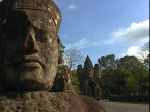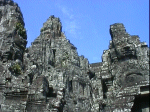Angkor Thom and The Bayon
Created | Updated Jun 21, 2003
Angkor Thom
This fortified city covers an area of 10 sq km and was built by the greatest of the Angkorian kings, Jayavarman VII, who ruled between 1181 and 1201. The previous capital had been sacked by invading Chams just before Jayavarman VII came to the throne.

Angkor Thom is surrounded by a wall eight metres high and twelve kilometres long. Outside the wall is a hundred metre wide moat that is reputed to have been filled with crocodiles.
The city has five gates (north, south, west, and two in the east wall). In front of each gate was a causeway each with statues of fifty four gods on the left and fifty four demons on the right.
The Bayon
Built by Jayavarman VII, the Bayon is the second most popular place to visit after Angkor Wat. Standing in the exact centre of Angkor Thom, the precise function and symbolism are still a mystery. From a distance is seems to be just a pile of jumbled rocks.


Once one gets closer to the temple, individual towers can be made out. Each of the fifty four towers are decorated with four massive faces of Avalokiteshvara.
The temple is a maze of staircases and dark passages and so it is easy to feel that one is alone. It is only on reaching the central third level that crowds may become apparent.
As with all of the temples of Angkor, the Bayon is still in use. While wandering through the dark corridors, suddenly one will be confronted by a statue of The Buddha and given the opportunity to make an offering of joss sticks, flowers or simply cash.
Apart from the colossal heads, the Bayon is also famous for its 1200 metres of bas reliefs running around the outer wall of the first level. The scenes range from the wars with the Chams, victory celebrations, and depictions of daily life in the 12th century.

